Types of Aquatic Bodywork
Several forms of bodywork in water exist, each with its own focus and direction, and include Watsu, Aquassage, Waterdance, Healing dance, Dolphin dance and Jahara technique. Aquatic bodywork has been applied across a wide spectrum – from very clinical work to deep, heart-space connection and healing. It all depends on what’s appropriate for that client and that practitioner.
Aquassage
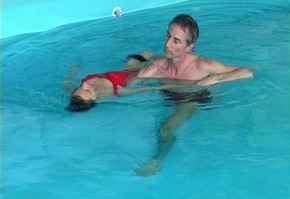
Aquasssage was developed by Maria Gerondoudis in South Africa and uses a combination of reflexology, massage, hara work, acupressure, wave movements and gentle stretches to mobilise joints and soft tissue while the client is floated on special floats taylored to the client's unique requirements. It is designed for people with mobility problems, soft tissue disorders and injuries, certain types of pain and neurological conditions which do not tolerate vigorous movement and deep stretching, and is most suitable for people that are sensitive to motion-sickness or who prefer a generous amount of personal space.
Water Shiatsu (Watsu)
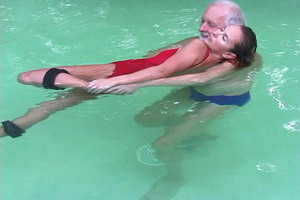
Water Shiatsu or Watsu, was developed by the Harold Dull in the USA and is based on oriental methods of acupressure massage while applying the stretches and principles of Zen Shiatsu. You are floated, held, massaged, rhythmically moved, and stretched into what one recipient described as ‘noodle consistency’. Multidimensional stretching has been found to release blockages in our meridians, the channels through which our “chi’, or life force, flows. Warm water provides an ideal environment for the whole body to be stretched and manipulated in flowing movements. It is believed that emotions and memories of an event or trauma can be stored in the body’s tissues. The release of energy and tension in these tissues can allow these emotions to surface and be released. Watsu frees the spine and stretches new life into neglected tissue and muscles.
Your nose and mouth are kept above water throughout the session.
Waterdance
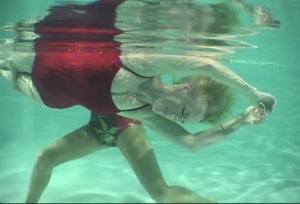
Waterdance is a dynamic form of underwater aquatic bodywork developed in 1987 by Arjana Brunschwiler and Peter Aman Schröter. As you float and relax at the water’s surface, your breathing gradually becomes calmer, deeper, and slower. You wear a nose-clip and are guided into the weightless, three-dimensionality of the underwater world. Extensions, stretches, flexions, dolphin-like movements and snake-like rhythms release not only on physical level, but allow the deepest states of relaxation and meditation to be experiences, sometimes even returning us to memories of the womb. The dive reflex is activated and the breath and heart rate slow down. It is a profound therapy, in which time and space loose their meaning. Life and being become a flow. Regression often occurs in which wounds from the past can be effortlessly processed. Waterdance offers us, on the one hand, a strong and powerful therapeutic instrument, and on the other hand, a form of energy work and bodywork.
Play, surrender, flow and harmony all combine in a unique manner in the warm water.
Jahara Technique
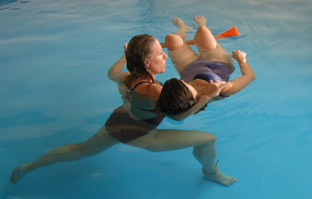
This is a technique developed by Mario Jahara from Brazil , and relies on the principles of support, adaptability, expansion, effortlessness, and invisibility. Aided by a flexible floatation device called the Third Arm, the Jahara technique consists of continuous circular movements combined with micro-adjustments of the structural alignment of the body. The therapist provides precise support to the body structure. This support, along with gentle traction movements, elongates the spine and decompresses the neuro-musculoskeletal system. The technique is quiet and meditative, while utilizing pressure points, consistency, and precision. Jahara was developed more for clinical conditions and is often found in the paradigm of aquatic rehabilitation. It uses gentle traction to the spine, which leads to an expansion in the body.
Healing Dance
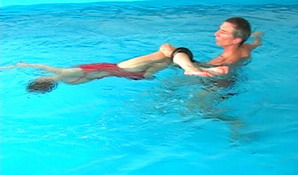
Healing dance is a bridge between Waterdance and Watsu, and brings the joy and exhilaration of the dance into the therapy pool. It was developed by professional ballet dance and choreographer Alexander Georgeakopoulos in 1990 and contains elements of Watsu, Trager work, Waterdance and pure movement. Watsu instructor and WABA board member Theri Thomas says, “In fact, the movement is the medicine”. The healing power of dance and submersion is harnessed in hydrodynamic and spacious swirls, quiet embraces, releases, tractions and smooth transitions. Twenty different, undulating, spiral and wave movements are used above and below the water to integrate the body in a rhythmic experience that helps release blocked energies in a continuous flow.
Alexander is one of WABA’s senior instructors; since 1991 he has led over 170 week-long 50-hour intensives in Anatomy, Massage, Barefoot Shiatsu, Watsu, HealingDance and WaterDance. Alexander presently leads trainings in US, Europe, Israel and Brazil , teaching in English, German or Portuguese as required.
Dolphin Dance
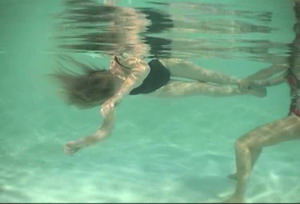
Combining the nurturing calmness and structure of Waterdance with the movement and spontaneity of Healing dance, this is an underwater technique which is nurturing and safe, but which is interactive and helps the client to express the dance, movement, or stillness that is inside them. It is used in workshops with wild dophins in the ocean, or in a swimming pool. Dolphins exercise an innate intuition and sensitivity to needs, which is communicated primarily through movement. "This is the part of myself I tap into to in dolphin dance. I gently and rhythmically move the client to explore and use the space under water. I bond with their breathing and know when they need to breathe. Each session is unique, because each person chooses to express the aspect of themselves that surfaces in that space at that time. The presence and interaction of wild dolphins adds a healing dimension that is very powerful. The pace and nature of the session change continuously. It may trigger a sense of foetal safety, and help someone release trauma, or it may simply help express freedom and joy. Whatever form it takes, the deep connection (what Harold Dull calls ‘heart-connection’) and flowing exchange between client, practitioner and nature allows the client to experience the world below the water’s surface with unprecedented freedom, harmony, and grace." says Maria